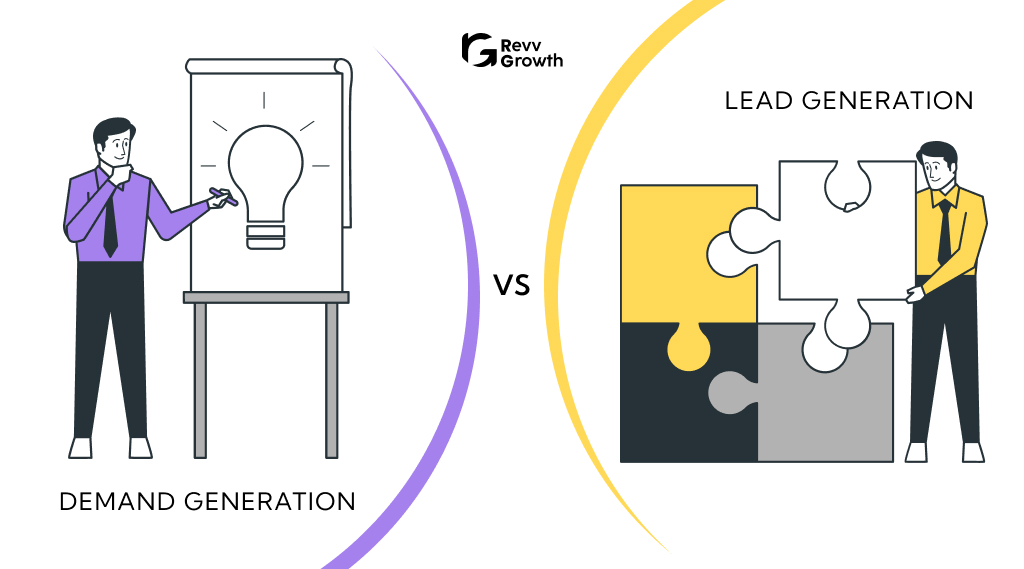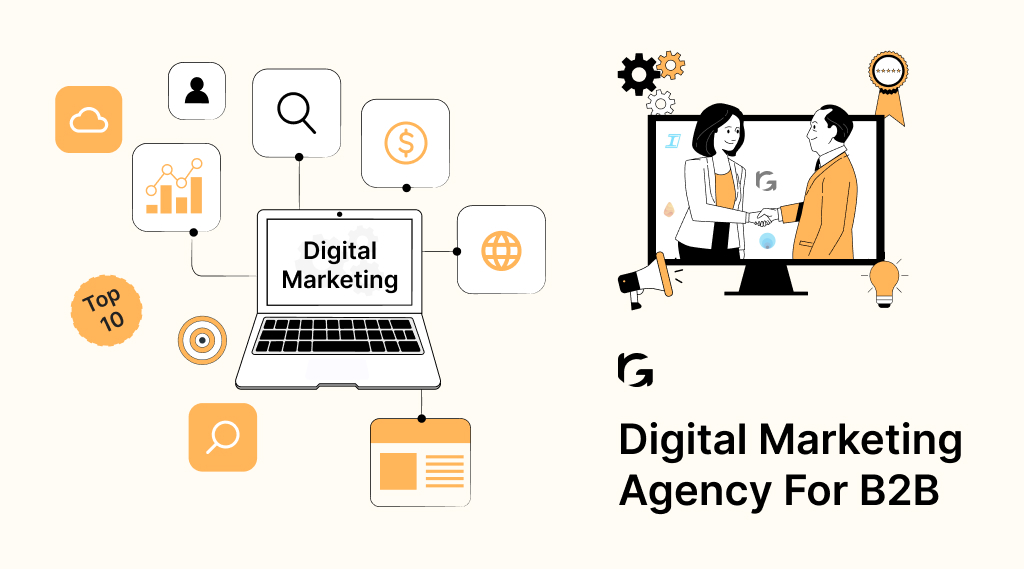Introduction
Demand generation is about building brand identity and attracting a broad audience, while lead generation is about capturing contact information from interested prospects to facilitate the conversion process.
Both are crucial for a comprehensive marketing strategy, with demand generation feeding the top of the funnel and lead generation advancing prospects through the sales process.
What is demand generation?
Demand generation is a sort of inbound marketing that refers to the whole marketing plan (or “marketing funnel“) that generates interest in your brand’s product or services.
While a demand generation plan technically spans the complete customer journey from interest to lead generation, thinking about demand generation through the perspective of how a potential consumer feels about your product or service is a simpler approach to think about it.
A demand generation marketing plan begins by determining how well a potential audience understands your brand, then developing ways to expose that brand to a new buyer group, and then sustaining that connection by establishing trust and authority.
What is the problem that your brand can address, and how much faith does your consumer have in your brand to solve that problem? This is especially crucial in business-to-business demand generation, since other companies are looking for ways to get their own brands into the market.
Demand generation strategies can range from social media brand awareness campaigns to thought leadership (webinars, eBooks, white papers, etc.) in your company’s sector.
At the end of the day, demand generation is primarily concerned with ensuring that your target audience is aware of the brand you represent, the value it represents, and the trust that the consumer should have in your brand.
Demand generation has the ability to improve the whole customer journey, whether it’s about increasing demand for a product or the sales team following qualified leads.
What is lead generation?
Lead generation refers to the process of identifying and cultivating potential customers (leads) for a business’s products or services. The primary objective of lead generation is to capture the interest of individuals or organizations who are likely to be interested in what the business offers and to gather their contact information for further engagement.
Lead generation typically involves various marketing tactics and channels, such as content marketing, email marketing, social media marketing, search engine optimization (SEO), pay-per-click (PPC) advertising, and more. These tactics aim to attract and capture the attention of potential leads, encouraging them to provide their contact details through forms, subscriptions, or other means.
Once a lead’s information is collected, it is usually passed on to the sales team for further nurturing and conversion into customers. Effective lead generation strategies not only focus on capturing contact information but also on qualifying leads based on their likelihood to convert into paying customers, ensuring that the sales team focuses its efforts on the most promising prospects.
Demand generation vs lead generation : What is the difference?
Demand generation focuses on increasing brand recognition and interest, whereas lead generation focuses on identifying and capturing individuals or businesses who are closer to completing a purchase. Both techniques have a place in the marketing and sales processes and can be used in tandem to propel corporate success.
| Aspect | Demand Generation | Lead Generation |
| Objective | Create awareness and interest in a product/service | Gather information and identify potential customers |
| Focus | Broad audience | Specific audience |
| Goal | Educate, engage, and nurture prospects | Capture contact information of potential leads |
| Strategy | Content marketing, social media, SEO, events, etc. | Content marketing, email marketing, PPC, etc. |
| Metrics | Brand awareness, engagement metrics, website traffic | Lead quantity, lead quality, conversion rate |
| Timing | Long-term strategy | Short-term strategy |
| Conversion Intent | Indirect: No immediate purchase intent | Direct: Immediate purchase intent |
| Lead Handover Point | Before the prospect becomes a lead | After the prospect becomes a lead |
These differences outline how demand generation and lead generation strategies diverge in their approaches, goals, and target outcomes.
How do demand generation and lead generation work together?
Demand generation focuses on creating awareness, generating interest, and building relationships with a broad audience. It’s about casting a wide net to make potential customers aware of your brand and products. At its core, demand generation aims to establish brand awareness and trust, which are fundamental for success in today’s competitive market.
Lead generation, on the other hand, is more specialized. It zooms in on identifying and capturing high-intent sales leads. These are individuals or companies who have expressed a clear interest in your products or services and are closer to making a purchase decision. Lead generation is about converting this interest into actionable sales leads.
The Symbiotic Relationship
Here’s where the magic happens. Demand generation and lead generation, when orchestrated together, can deliver exceptional results. Let’s explore how:
1. Demand generation seeds the ground:
Demand generation lays the groundwork by creating brand awareness and trust. It attracts a broad audience and introduces your brand and offerings to potential customers. The content marketing, social media engagement, and brand advertising efforts in demand generation set the stage.
2. Lead generation nurtures the harvest:
Once demand generation has piqued interest, lead generation comes into play. It capitalizes on this interest by capturing contact information from those who are ready to engage further. Gated content, webinars, and email marketing are effective tools for lead generation.
3. Demand generation feeds the funnel:
The beauty of this symbiotic relationship is that the two strategies feed into each other. Leads generated through lead generation efforts can also be incorporated into demand generation initiatives. This creates a continuous cycle of attracting, engaging, and converting potential customers.
4. Keyword harmony:
Keywords play a pivotal role in this relationship. In both demand generation and lead generation, keyword research is critical. Identifying and targeting the right keywords ensures your content reaches the right audience. Keywords should align with your brand, products, and the pain points your offerings address.
Finally, demand generation and lead generation are not antagonistic forces, but rather complementing tactics. When these two marketing titans collaborate, they produce a symphonic symphony that increases brand awareness, trust, and high-quality leads. The key to success is collaboration.
In today’s competitive world, harness the power of demand generation and lead generation in your marketing plan and watch your business prosper.
Conclusion
Demand generation is the process of creating brand awareness and interest, targeting a broad audience to educate them about products or services. The primary contrast between demand and lead generation is their focus, with demand generation focusing on raising awareness and lead generation on acquiring particular leads.
Demand generation aims to create awareness, generate interest, and educate a broad audience about a product or service. It focuses on building brand recognition and trust, nurturing prospects over the long term, and influencing their purchasing decisions indirectly. Strategies such as content marketing, social media engagement, and SEO are commonly employed in demand generation efforts.
On the other hand, lead generation is more targeted and aims to identify and capture specific individuals or organizations who have expressed interest in a product or service. Its primary goal is to gather contact information and qualify leads based on their likelihood to convert into customers.
Lead generation strategies often involve tactics like email marketing, PPC advertising, and gated content to prompt immediate action from potential leads.
While both demand generation and lead generation play essential roles in driving business growth, understanding their differences and integrating them effectively into the overall marketing strategy is key to maximizing results and achieving sustainable success.
Ready to take your marketing efforts to the next level? Check this out to learn how we can help you create a comprehensive strategy that builds brand awareness and drives high-quality leads.


